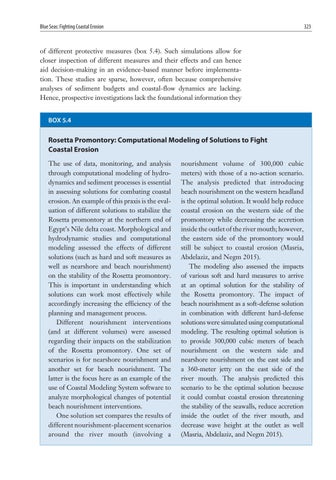Blue Seas: Fighting Coastal Erosion
323
of different protective measures (box 5.4). Such simulations allow for closer inspection of different measures and their effects and can hence aid decision-making in an evidence-based manner before implementation. These studies are sparse, however, often because comprehensive analyses of sediment budgets and coastal-flow dynamics are lacking. Hence, prospective investigations lack the foundational information they BOX 5.4
Rosetta Promontory: Computational Modeling of Solutions to Fight Coastal Erosion The use of data, monitoring, and analysis through computational modeling of hydrodynamics and sediment processes is essential in assessing solutions for combating coastal erosion. An example of this praxis is the evaluation of different solutions to stabilize the Rosetta promontory at the northern end of Egypt’s Nile delta coast. Morphological and hydrodynamic studies and computational modeling assessed the effects of different solutions (such as hard and soft measures as well as nearshore and beach nourishment) on the stability of the Rosetta promontory. This is important in understanding which solutions can work most effectively while accordingly increasing the efficiency of the planning and management process. Different nourishment interventions (and at different volumes) were assessed regarding their impacts on the stabilization of the Rosetta promontory. One set of scenarios is for nearshore nourishment and another set for beach nourishment. The latter is the focus here as an example of the use of Coastal Modeling System software to analyze morphological changes of potential beach nourishment interventions. One solution set compares the results of different nourishment-placement scenarios around the river mouth (involving a
nourishment volume of 300,000 cubic meters) with those of a no-action scenario. The analysis predicted that introducing beach nourishment on the western headland is the optimal solution. It would help reduce coastal erosion on the western side of the promontory while decreasing the accretion inside the outlet of the river mouth; however, the eastern side of the promontory would still be subject to coastal erosion (Masria, Abdelaziz, and Negm 2015). The modeling also assessed the impacts of various soft and hard measures to arrive at an optimal solution for the stability of the Rosetta promontory. The impact of beach nourishment as a soft-defense solution in combination with different hard-defense solutions were simulated using computational modeling. The resulting optimal solution is to provide 300,000 cubic meters of beach nourishment on the western side and nearshore nourishment on the east side and a 360-meter jetty on the east side of the river mouth. The analysis predicted this scenario to be the optimal solution because it could combat coastal erosion threatening the stability of the seawalls, reduce accretion inside the outlet of the river mouth, and decrease wave height at the outlet as well (Masria, Abdelaziz, and Negm 2015).






